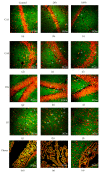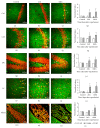Prophylactic Subacute Administration of Zinc Increases CCL2, CCR2, FGF2, and IGF-1 Expression and Prevents the Long-Term Memory Loss in a Rat Model of Cerebral Hypoxia-Ischemia
- PMID: 26355725
- PMCID: PMC4556331
- DOI: 10.1155/2015/375391
Prophylactic Subacute Administration of Zinc Increases CCL2, CCR2, FGF2, and IGF-1 Expression and Prevents the Long-Term Memory Loss in a Rat Model of Cerebral Hypoxia-Ischemia
Abstract
Prophylactic subacute administration of zinc decreases lipoperoxidation and cell death following a transient cerebral hypoxia-ischemia, thus suggesting neuroprotective and preconditioning effects. Chemokines and growth factors are also involved in the neuroprotective effect in hypoxia-ischemia. We explored whether zinc prevents the cerebral cortex-hippocampus injury through regulation of CCL2, CCR2, FGF2, and IGF-1 expression following a 10 min of common carotid artery occlusion (CCAO). Male rats were grouped as follows: (1) Zn96h, rats injected with ZnCl2 (one dose every 24 h during four days); (2) Zn96h + CCAO, rats treated with ZnCl2 before CCAO; (3) CCAO, rats with CCAO only; (4) Sham group, rats with mock CCAO; and (5) untreated rats. The cerebral cortex-hippocampus was dissected at different times before and after CCAO. CCL2/CCR2, FGF2, and IGF-1 expression was assessed by RT-PCR and ELISA. Learning in Morris Water Maze was achieved by daily training during 5 days. Long-term memory was evaluated on day 7 after learning. Subacute administration of zinc increased expression of CCL2, CCR2, FGF2, and IGF-1 in the early and late phases of postreperfusion and prevented the CCAO-induced memory loss in the rat. These results might be explained by the induction of neural plasticity because of the expression of CCL2 and growth factors.
Figures







References
-
- Blanco-Alvarez V. M., Lopez-Moreno P., Soto-Rodriguez G., et al. Subacute zinc administration and L-name caused an increase of NO, Zinc, lipoperoxidation, and caspase-3 during a cerebral hypoxia-ischemia process in the rat. Oxidative Medicine and Cellular Longevity. 2013;2013:10. doi: 10.1155/2013/240560.240560 - DOI - PMC - PubMed
Publication types
MeSH terms
Substances
LinkOut - more resources
Full Text Sources
Other Literature Sources
Medical
Miscellaneous

